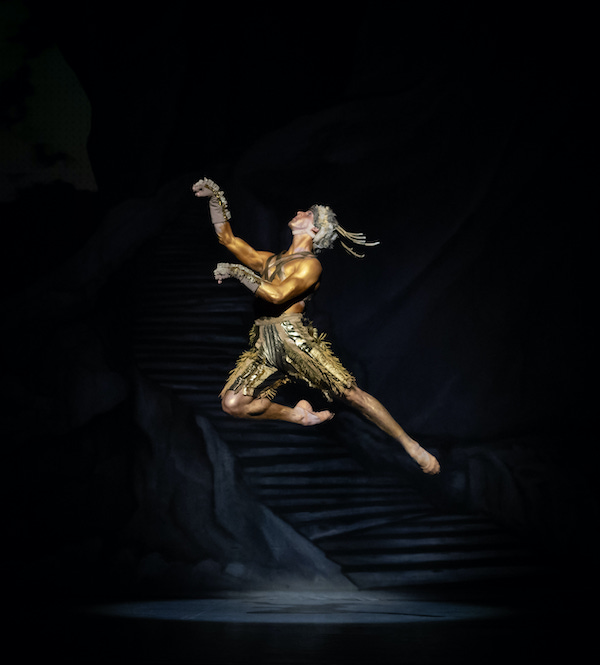If you have a sweet tooth when it comes to ballet then Javier Torres’s Sleeping Beauty should satisfy, says Kim Balfour. But if you’re looking for reinvention rather than convention, you won’t find it here.
Too many soft centres in chocolate box ballet
22 November 2021
- Reading time • 6 minutesDance
More like this
- How to watch ballet
- Fairytale leaps to life with fun twist
- Beauty and tragedy echo from canvas to stage
Sleeping Beauty, WA Ballet ·
His Majesty’s Theatre, 18 November 2021 ·
Classical ballet is not a format where anyone should seriously expect to find a plausible plot.
Coppelia’s Franz falls for a life-size dancing doll, and Swan Lake’s Prince Siegfried thought his beloved Odette was just going through a goth phase.
But they all, more or less, have an obvious story structure on which to hang the dance elements.
Sleeping Beauty, by comparison, all but dispenses with any such pretence, instead opting to invite over a cast of eccentric friends for a huge opulent fairy tale themed dance party. If that seems like fun to you, then you’ll enjoy West Australian Ballet’s current production, by Mexican-Finnish choreographer Javier Torres after Marius Petipa.
Pyotr Ilyich Tchaikovsky’s Sleeping Beauty is his longest ballet score; an evening of Petipa’s 1890 ballet would have cost four hours of your time. As if hacking through a wall of thorny vines, Torres has pruned back extraneous parts of Sleeping Beauty and expanded others.
Torres says he wanted to make Sleeping Beauty “a multisensory experience” and to make classical ballet “more accessible to a wider modern audience”. In an attempt to avoid binary good versus evil tropes, Torres instead explores the relationship between love and fear (conjuring some serious Donnie Darko vibes), represented by the fairies Lilac and Carabosse respectively.
Torres’ Baroque ballet is jam packed with a plethora of short and sweet variations, delightfully complemented by Jessica Gethin and the West Australian Philharmonic Orchestra, which keeps the “accessible multisensory” experience rolling along.
In fact, the production line of variations is so tightly packed you’d be forgiven for thinking you’re watching an eisteddfod. Torres has enriched and embellished this vast chocolate box of dazzling, hyperactive dance bites, adding sprinkles of sparkle and colour that clearly delighted the opening night audience.
As the Lilac Fairy, the character who most often propels the narrative, Alexa Tuzil’s performance was one of grace, poise, and honed technique.
The gender fluid role of Carabosse was shared by Kiki Saito and Juan Carlos Osma, who both gave wickedly transfixing performances, imbued with sinewy virtuosity, power and litheness. Carabosse has an army of really cool looking bats that definitely need their own spin-off cabaret show.

In Act II, we also see a bunch of graceful deer leaping their way through a lush forest glade, alongside a shimmering Golden Deer danced with muscular confidence by Julio Blanes. All credit to set designer Minna Wallenius, costume designer Erika Turunen, and lighting designer Nigel Levings for these and other magical fairy tale moments.
Sleeping Beauty is full of en pointe endurance tests, much like watching an Olympics with a beauty aesthetic. Act I’s famous Rose Adagio, where Aurora cycles through four suitors while balanced in attitude derrière en pointe, is always a thrill ride for audiences, and Chihiro Nomura didn’t disappoint.
Act III sees the storyline abruptly wrapped up. Prince Desiré, Oscar Valdes, quickly defeats Carabosse and awakens Aurora with a kiss, before we move on to the wedding, more variations, and the main pas de deux. White Cat (Carina Roberts), Puss in Boots (Ruben Flynn-Kann) and Street Cat (Oliver Edwardson) are fun, as are the other fairy tale wedding guests.
Nomura and Valdes performed the main pas de deux, solos and coda with careful precision, demonstrating assured technical brilliance, virtuosity, and partnering chemistry. Arguably one element missing was light and shade from an otherwise highly skilled pair of dancers performing complex routines with apparent ease.
Streamlining Sleeping Beauty, an otherwise oddly structured, protracted, confused mess of a ballet, is a perfectly reasonable approach. But aside from some heavy editing and a few clever artistic embellishments, Torres’ Sleeping Beauty is a Christmas crowd-pleaser that leans heavily on convention rather than reinvention.
While many audience members clearly enjoyed scrolling from one novelty scene to the next, others may see a lost opportunity to do something truly original with this now well-worn material.
Whether or not you enjoy Torres’ version of Sleeping Beauty really depends on the expectations you take into the theatre with you.
Sleeping Beauty continues until 12 December 2021.
Pictured top: Juan Carlos Osma as Prince Desiré and Alexa Tuzil as Princess Aurora in ‘The Sleeping Beauty’. Photo: Bradbury Photography. (Please note that the photos supplied by WA Ballet are not of the cast viewed, due to last minute casting changes.)
Like what you're reading? Support Seesaw.






